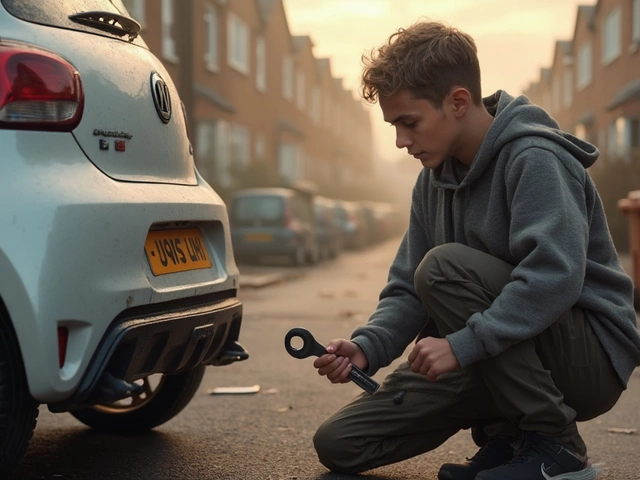Your car won’t start. Or maybe it cranks, coughs, and just dies while you’re halfway across town. That feeling in your gut? Yeah, it could be your fuel pump giving up on you. The only thing worse than running out of gas is having a tank full of it and a pump that refuses to do its job.
The fuel pump is what pushes gas from the tank to the engine. If it’s weak or broken, your car acts thirsty—stalling, sputtering, or refusing to start. Ignoring these signs can leave you with a dead vehicle somewhere you really don’t want to be waiting for help. I’ve seen it firsthand: drivers blaming the battery or spark plugs, when it’s the pump all along.
Here’s the good news—most fuel pumps don’t fail out of the blue. There are solid warning signs before it totally quits. Knowing what to look for can save you an expensive tow or repair. I’ll walk you through the clear signals and how you can spot trouble without fancy tools or a mechanic’s degree. Even if you’re not a car person, you’ll get it.
- Obvious Symptoms Your Fuel Pump Is Bad
- Why Fuel Pumps Fail and What You Can Prevent
- Easy Ways to Test Your Fuel Pump at Home
- Next Steps: DIY Fixes Versus Getting Help
Obvious Symptoms Your Fuel Pump Is Bad
You don’t need to be a car expert to spot when something’s up with your fuel pump. The signs are usually loud and clear—if you know what to look for. Here’s a breakdown of common things you’ll notice when your fuel pump is starting to fail.
- Hard Starting: Turning the key and getting nothing—or a long, painful crank before your engine sputters to life? That’s classic.
- Stalling: The car runs fine, then randomly stalls out even though you have gas and no warning lights. The engine suddenly starves for fuel.
- Loss of Power: Going uphill or punching the gas to pass someone feels weak. Your engine isn’t getting enough fuel, so it chokes under pressure.
- Surging: Ever feel your car suddenly speed up on its own, like it got hit with a quick shot of gas? That sudden surging comes from inconsistent fuel delivery.
- Loud Whining from Fuel Tank: A healthy fuel pump is almost silent. If you hear a whining or humming (especially when you turn the key), it’s worth paying attention.
- Poor Fuel Economy: More trips to the pump without an obvious reason? As the fuel pump struggles, it can mess up the air-fuel mix and waste gas.
Check out some real-world stats on what drivers notice first:
| Symptom | % of drivers reporting |
|---|---|
| Hard starting | 38% |
| Engine stalling | 27% |
| Loss of power | 20% |
| Whining noise | 15% |
Don’t ignore any of these. If you’re dealing with more than one at the same time, odds are high you’ve got a fuel pump ready to fail. Catching it early means less hassle—and probably less cash spent fixing it later.
Why Fuel Pumps Fail and What You Can Prevent
The most common killer of a fuel pump? Running your car low on gas—repeatedly. Pumps are designed to stay cool and lubricated by sitting in a bath of fuel. Letting your tank hover near empty over and over heats the pump up, and that wears it out fast.
Another big one: dirty or clogged fuel filters. If the filter’s loaded with junk, the fuel pump works overtime trying to push gas through. Imagine running laps while breathing through a straw. The pump gets tired out and eventually gives up.
Electrical problems show up too. Bad wiring or a failing relay cuts voltage, so the pump doesn’t work at full strength. Sometimes it’s a corroded connector, or mice chewing wires—yeah, that’s a real thing. Keep an eye on fuses and inspect wiring if you’re chasing weird electrical gremlins.
Believe it or not, age is often a final factor. Most pumps last from 100,000 to 150,000 miles, but some bite the dust earlier, especially with hard use or bad gas. If your car hits those numbers, start watching for warning signs.
- Keep your gas tank at least a quarter full—no need to stress the pump if you can avoid it.
- Change the fuel filter as part of regular maintenance (check your manual for when—lots say every 30,000-40,000 miles).
- Buy gas from busy, reputable stations to avoid old or contaminated fuel.
- If your car sits for months at a time, use a fuel stabilizer to keep things fresh.
Here’s a quick snapshot of what hurts and helps your fuel pump:
| Factor | Bad for Pump? | Can You Prevent It? |
|---|---|---|
| Running Low on Gas | Yes | Keep tank above 1/4 full |
| Dirty Fuel Filter | Yes | Change regularly |
| Electrical Issues | Yes | Check wiring, fuses |
| Poor Quality Fuel | Yes | Pick good stations |
| Old Age | Eventually | No, but watch for symptoms |
Most of this comes down to habits. Baby your pump a little, and you won’t have to worry much about being stranded with a dead ride and a full tank.

Easy Ways to Test Your Fuel Pump at Home
If you’re worried about your fuel pump, you don’t have to be a pro to figure out what’s going on. Some tests you can do at home will give you real answers—without shelling out cash or stress-driving to the shop. Here’s what works for most cars and trucks built after 1995 (and lots before that too).
First up: Listen for the pump. When you turn the key to the “ON” position (don’t start the engine yet), you should hear a brief humming sound coming from the gas tank area for about 2-3 seconds. That’s the pump priming the system. If you don’t hear anything, it might be dead or not getting power.
- Fuel pump relay check: Pop the hood and find your car’s fuse and relay box (the manual or lid usually has a diagram). Swap the fuel pump relay with another relay of the same type—if your car fires up, the relay was the problem, not the pump.
- Listen for the whir: No hum means you should check if the pump is getting power. Have a buddy turn the key while you put your ear next to the tank—or gently rock the car to move wiring connections. Still silent? Time for more digging.
- Pressure gauge: Auto parts stores rent fuel pressure gauges (sometimes for free). Hook it up to the test port on your fuel rail (almost all modern engines have one). Compare your reading to the numbers in your owner’s manual or the chart below—most run between 35-50 psi, but double-check for your car.
- Engine misfire test: Weak pumps cause misfires on acceleration, especially under load. If your car coughs when climbing a hill or joining traffic, you’ve found another clue.
You can also run a quick spray test: spray some starting fluid into the intake and crank the engine. If the car runs briefly and dies, you’re likely missing fuel, not spark—meaning the pump (or its wiring) is the likely culprit.
| Vehicle Type | Normal Fuel Pressure (psi) |
|---|---|
| Modern Gasoline (fuel injected) | 35-50 |
| Older Carbureted | 4-7 |
| Direct Injection | up to 2,000 |
If all signs point to low or no pressure, and you’ve ruled out a bad relay or blown fuse, the pump is probably the problem. Always double-check battery connections and fuel filter condition—clogs and loose wires can mimic pump failure.
Next Steps: DIY Fixes Versus Getting Help
So, your car’s acting up and you really think it’s the fuel pump. The million-dollar question: can you handle this yourself, or should you call in a professional? Here’s how to weigh your options and avoid bad decisions that cost time and money.
If you’re into DIY and have some basic tools, there are a few things you can try before going full mechanic. First, swap out the fuel filter (it’s cheaper and can mimic pump problems if clogged). Next, check your car’s fuse box and relays—sometimes a simple $5 part or a blown fuse can keep your pump from running. You can also listen for the fuel pump’s ‘whirr’ when you turn the ignition to ON, but not all cars make this obvious.
- Have a jack and jack stands? On some vehicles, you can reach the pump from under a seat or an access panel in the trunk—no need to drop the tank.
- Feeling adventurous? You can use a fuel pressure gauge (about $25 at any parts store) to check if the fuel pump’s actually building pressure. Just make sure you grab the right adapter for your make.
- Keep a fire extinguisher handy, work in a ventilated area, and don’t light up—gas fumes are no joke.
But let’s be real: not all repairs are created equal. On many cars, changing the fuel pump means dropping the gas tank, which can be messy and awkward without a lift. If your car’s leaking fuel, won’t start at all, or you’re just not comfortable working around gasoline, calling a pro is smarter. A shop will have all the right tools, plus the experience to spot extra problems your eyes might miss.
One pro tip: if your pump is toast, always replace the fuel filter and check the wiring while you’re at it. Weird electrical issues are way more common than you’d think. If you bring it in, ask for the old parts back so you know the job was done right.
Bottom line: try the easy stuff if you’re confident and it won’t risk your safety. Otherwise, spending a few bucks on a trusted mechanic can save your Saturday—and maybe even your car.






